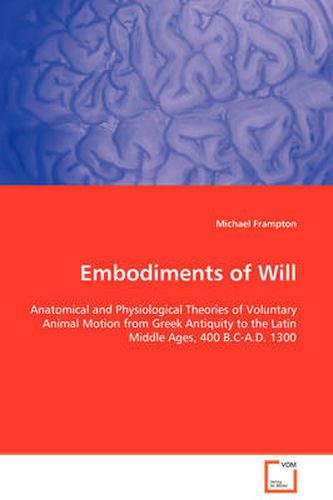Readings Newsletter
Become a Readings Member to make your shopping experience even easier.
Sign in or sign up for free!
You’re not far away from qualifying for FREE standard shipping within Australia
You’ve qualified for FREE standard shipping within Australia
The cart is loading…






This title is printed to order. This book may have been self-published. If so, we cannot guarantee the quality of the content. In the main most books will have gone through the editing process however some may not. We therefore suggest that you be aware of this before ordering this book. If in doubt check either the author or publisher’s details as we are unable to accept any returns unless they are faulty. Please contact us if you have any questions.
This book examines the two chief anatomical and physiological embodi ment theories of voluntary animal motion, which I call the cardiosinew and cerebroneuromuscular theories of motion, from the time of Aristotle (384-322 B.C.) to that of Mondino (d. A.D. 1326). The study of animal motion commenced with the ancient Greek natural scientist Aristotle who wrote the monograph ‘On the motion of animals’ (De motu animalium). Subsequent inquiries into voluntary animal motion may be found in a variety of Greek, Latin, and Arabic compendia, commentaries, and encyclopedias throughout the ancient and medieval periods. The motion of animals was considered relevant to natural philosophers and theologians investigating the nature of the soul, and to physicians seeking to discover the causes of disorders of voluntary movement such as epilepsy and tetany. The book fills a gap in the scholarly literature concerned with pre-modern studies of the anatomical and physiological mechanisms of will and bodily movement. The accompanying photographs of my own anatomical dissections illuminate ancient and medieval conceptual, empirical, and experimental methods of anatomical and physiological research.
$9.00 standard shipping within Australia
FREE standard shipping within Australia for orders over $100.00
Express & International shipping calculated at checkout
This title is printed to order. This book may have been self-published. If so, we cannot guarantee the quality of the content. In the main most books will have gone through the editing process however some may not. We therefore suggest that you be aware of this before ordering this book. If in doubt check either the author or publisher’s details as we are unable to accept any returns unless they are faulty. Please contact us if you have any questions.
This book examines the two chief anatomical and physiological embodi ment theories of voluntary animal motion, which I call the cardiosinew and cerebroneuromuscular theories of motion, from the time of Aristotle (384-322 B.C.) to that of Mondino (d. A.D. 1326). The study of animal motion commenced with the ancient Greek natural scientist Aristotle who wrote the monograph ‘On the motion of animals’ (De motu animalium). Subsequent inquiries into voluntary animal motion may be found in a variety of Greek, Latin, and Arabic compendia, commentaries, and encyclopedias throughout the ancient and medieval periods. The motion of animals was considered relevant to natural philosophers and theologians investigating the nature of the soul, and to physicians seeking to discover the causes of disorders of voluntary movement such as epilepsy and tetany. The book fills a gap in the scholarly literature concerned with pre-modern studies of the anatomical and physiological mechanisms of will and bodily movement. The accompanying photographs of my own anatomical dissections illuminate ancient and medieval conceptual, empirical, and experimental methods of anatomical and physiological research.